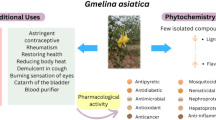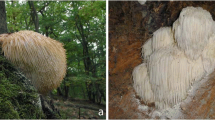Abstract
Monascus-fermented products have been used in food, medicine, and industry dating back over a thousand years in Asian countries. Monascus-fermented products contained several bioactive metabolites such as pigments, polyketide monacolins, dimerumic acid, and γ-aminobutyric acid. Scientific reports showed that Monascus-fermented products proved to be effective for the management of blood cholesterol, diabetes, blood pressure, obesity, Alzheimer’s disease, and prevention of cancer development. This review article describes the beneficial effects about using Monascus-fermented products in human beings and animals.







Similar content being viewed by others
References
Akihisa T, Tokuda H, Yasukawa K, Ukiya M, Kiyota A, Sakamoto N, Suzuki T, Tanabe N, Nishino H (2005) Azaphilones, furanoisophthalides, and amino acids from the extracts of Monascus pilosus-fermented rice (red-mold rice) and their chemopreventive effects. J Agric Food Chem 53:562–565
Brown MS, Goldstein JL (1984) How LDL receptors influence cholesterol and atherosclerosis. Sci Am 251:58–66
Chen F, Hu X (2005) Study on red fermented rice with high concentration of monacolin K and low concentration of citrinin. Int J Food Microbiol 103:331–337
Chen CC, Liu IM (2006) Release of acetylcholine by Hon-Chi to raise insulin secretion in Wistar rats. Neurosci Lett 404:117–121
Chen WP, Ho BY, Lee CL, Lee CH, Pan TM (2008) Red mold rice prevents the development of obesity, dyslipidemia and hyperinsulinemia induced by high-fat diet. Int J Obes (Lond) 32:1694–1704
Endo A (1979) Monacolin K, a new hypocholesterolemic agent produced by a Monascus species. J Antibiot (Tokyo) 32:852–854
Hanika C, Carlton WW (1994) Toxicology and pathology of citrinin. In: Llewellyn GG, Dashek WV, O'Rear CE (eds) Biodeterioration research, vol 4. Plenum, New York, pp 41–63
Hetherington AC, Raistrick H (1931) Studies in the biochemistry of micro-organism. XI. On the production and chemical constitution of a new yellow colouring matter, citrinin, produced from glucose by Penicillium citrinum Thom. Philos Trans R Soc Lond B 220:269–297
Ho BY, Pan TM (2009) The Monascus metabolite monacolin K reduces tumor progression and metastasis of Lewis lung carcinoma cells. J Agric Food Chem 57:8258–8265
Hsu WH, Lee BH, Pan TM (2010) Protection of Monascus-fermented dioscorea against DMBA-induced oral injury in hamster by anti-inflammatory and antioxidative potentials. J Agric Food Chem 58:6715–6720
Jeon T, Hwang SG, Hirai S, Matsui T, Yano H, Kawada T, Lim BO, Park DK (2004) Red yeast rice extracts suppress adipogenesis by down-regulating adipogenic transcription factors and gene expression in 3T3-L1 cells. Life Sci 75:3195–3203
Jou PC, Ho BY, Hsu YW, Pan TM (2010) The effect of Monascus secondary polyketide metabolites, monascin and ankaflavin, on adipogenesis and lipolysis activity in 3T3-L1. J Agric Food Chem 58:12703–12709
Juslova P, Martinkova L, Kren V (1996) Secondary metabolites of the fungus Monascus: a review. J Ind Microbiol 16:163–170
Kohama Y, Matsumoto S, Mimura T, Tanabe N, Inada A, Nakanishi T (1987) Isolation and identification of hypotensive principles in red-mold rice. Chem Pharm Bull (Tokyo) 35:2484–2489
Lee CL, Tsai TY, Wang JJ, Pan TM (2006a) In vivo hypolipidemic effects and safety of low dosage Monascus powder in a hamster model of hyperlipidemia. Appl Microbiol Biotechnol 70:533–540
Lee CL, Wang JJ, Kuo SL, Pan TM (2006b) Monascus fermentation of dioscorea for increasing the production of cholesterol-lowering agent-monacolin K and antiinflammation agent-monascin. Appl Microbiol Biotechnol 72:1254–1262
Lee CL, Chen WP, Wang JJ, Pan TM (2007a) A simple and rapid approach for removing citrinin while retaining monacolin K in red mold rice. J Agric Food Chem 55:11101–11108
Lee CL, Hung HK, Wang JJ, Pan TM (2007b) Improving the ratio of monacolin K to citrinin production of Monascus purpureus NTU 568 under dioscorea medium through the mediation of pH value and ethanol addition. J Agric Food Chem 55:6493–6502
Lee CL, Hung HK, Wang JJ, Pan TM (2007c) Red mold dioscorea has greater hypolipidemic and antiatherosclerotic effect than traditional red mold rice and unfermented dioscorea in hamsters. J Agric Food Chem 55:7162–7169
Lee CL, Kuo TF, Wang JJ, Pan TM (2007d) Red mold rice ameliorates impairment of memory and learning ability in intracerebroventricular amyloid beta-infused rat by repressing amyloid beta accumulation. J Neurosci Res 85:3171–3182
Lee CL, Wang JJ, Pan TM (2008) Red mold rice extract represses amyloid beta peptide-induced neurotoxicity via potent synergism of anti-inflammatory and antioxidative effect. Appl Microbiol Biotechnol 79:829–841
Lee CH, Lee CL, Pan TM (2010a) A 90-D toxicity study of Monascus-fermented products including high citrinin level. J Sci Food Agric 75:91–97
Lee CL, Kuo TF, Wu CL, Wang JJ, Pan TM (2010b) Red mold rice promotes neuroprotective sAPPalpha secretion instead of Alzheimer’s risk factors and amyloid beta expression in hyperlipidemic Aβ40-infused rats. J Agric Food Chem 58:2230–2238
Li SZ (1596) Pen Tsao Kang Mu (Compendium of Materia Medica, Systematic Pharmacopoeia). China
Li C, Zhu Y, Wang Y (1998) Monascus purpureus fermented rice (red yeast rice): a natural food product that lowers blood cholesterol in animal models of hypercholesterolemia. Nutr Res 18:71–81
Ma J, Li Y, Ye Q, Li J, Hua Y, Ju D, Zhang D, Cooper R, Chang M (2000) Constituents of red yeast rice, a traditional Chinese food and medicine. J Agric Food Chem 48:5220–5225
Sako F, Kobayashi N, Watabe H, Yokosawa N, Taniguchi N (1983) Induction of gamma-glutamyl transpeptidase and glutathione S-transferase in cultured fetal rat hepatocytes by laccaic acid and Monascus pigments. Chem Biol Interact 44:17–26
Shi YC, Pan TM (2010a) Anti-diabetic effects of Monascus purpureus NTU 568 fermented products on streptozotocin-induced diabetic rats. J Agric Food Chem 58:7634–7640
Shi YC, Pan TM (2010b) Antioxidant and pancreas-protective effect of red mold fermented products on streptozotocin-induced diabetic rats. J Sci Food Agric 90:2519–2525
Shi YC, Pan TM (2010c) Characterization of a multifunctional Monascus isolate NTU 568 with high azaphilone pigments production. Food Biotechnol 24:349–363
Singewald N, Kouvelas D, Mostafa A, Sinner C, Philippu A (2000) Release of glutamate and GABA in the amygdala of conscious rats by acute stress and baroreceptor activation: differences between SHR and WKY rats. Brain Res 864:138–141
Tsuji A, Sato H, Kume Y, Tamai I, Okezaki E, Nagata O, Kato H (1988) Inhibitory effects of quinolone antibacterial agents on gamma-aminobutyric acid binding to receptor sites in rat brain membranes. Antimicrob Agents Chemother 32:190–194
Wang JJ, Lee CL, Pan TM (2004) Modified mutation method for screening low citrinin-producing strains of Monascus purpureus on rice culture. J Agric Food Chem 52:6977–6982
Wang JJ, Shieh MJ, Kuo SL, Lee CL, Pan TM (2006) Effect of red mold rice on antifatigue and exercise-related changes in lipid peroxidation in endurance exercise. Appl Microbiol Biotechnol 70:247–253
Wild D, Toth G, Humpf HU (2002) New Monascus metabolite isolated from red yeast rice (angkak, red koji). J Agric Food Chem 50:3999–4002
Wu CL, Lee CL, Pan TM (2009) Red mold dioscorea has a greater antihypertensive effect than traditional red mold rice in spontaneously hypertensive rats. J Agric Food Chem 57:5035–5041
Yongsmith B, Kitprechavanich V, Chitradon L, Chaisrisook C, Budda N (2000) Color mutants of Monascus sp. KB9 and their comparative glucoamylases on rice solid culture. J Mol Catal 10:263–272
Author information
Authors and Affiliations
Corresponding author
Rights and permissions
About this article
Cite this article
Shi, YC., Pan, TM. Beneficial effects of Monascus purpureus NTU 568-fermented products: a review. Appl Microbiol Biotechnol 90, 1207–1217 (2011). https://doi.org/10.1007/s00253-011-3202-x
Received:
Revised:
Accepted:
Published:
Issue Date:
DOI: https://doi.org/10.1007/s00253-011-3202-x




